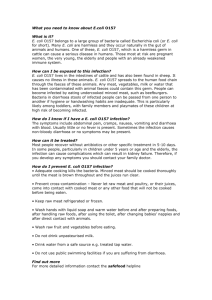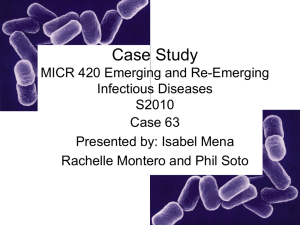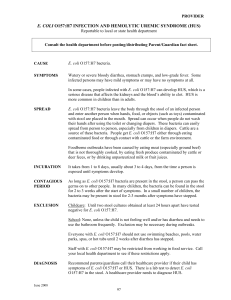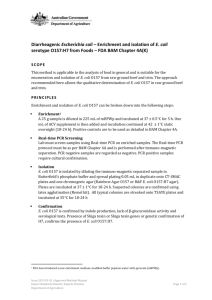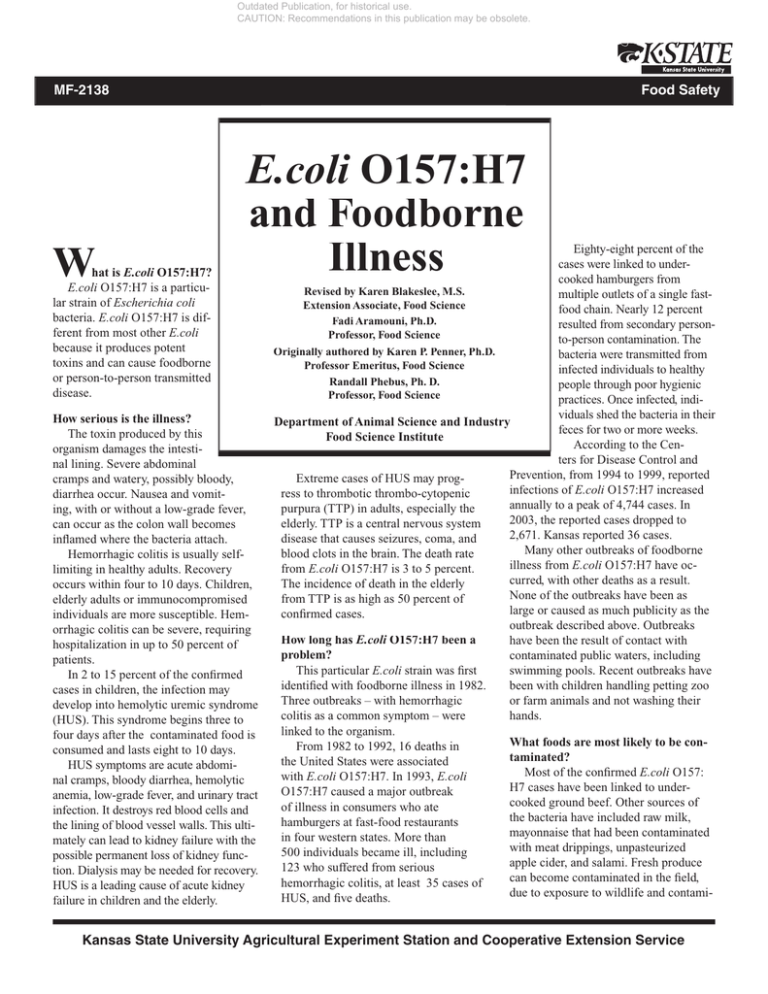
Outdated Publication, for historical use.
CAUTION: Recommendations in this publication may be obsolete.
MF-2138
W
hat is E.coli O157:H7?
E.coli O157:H7 is a particular strain of Escherichia coli
bacteria. E.coli O157:H7 is different from most other E.coli
because it produces potent
toxins and can cause foodborne
or person-to-person transmitted
disease.
Food Safety
E.coli O157:H7
and Foodborne
Illness
How serious is the illness?
The toxin produced by this
organism damages the intestinal lining. Severe abdominal
cramps and watery, possibly bloody,
diarrhea occur. Nausea and vomiting, with or without a low-grade fever,
can occur as the colon wall becomes
inflamed where the bacteria attach.
Hemorrhagic colitis is usually selflimiting in healthy adults. Recovery
occurs within four to 10 days. Children,
elderly adults or immunocompromised
individuals are more susceptible. Hemorrhagic colitis can be severe, requiring
hospitalization in up to 50 percent of
patients.
In 2 to 15 percent of the confirmed
cases in children, the infection may
develop into hemolytic uremic syndrome
(HUS). This syndrome begins three to
four days after the contaminated food is
consumed and lasts eight to 10 days.
HUS symptoms are acute abdominal cramps, bloody diarrhea, hemolytic
anemia, low-grade fever, and urinary tract
infection. It destroys red blood cells and
the lining of blood vessel walls. This ultimately can lead to kidney failure with the
possible permanent loss of kidney function. Dialysis may be needed for recovery.
HUS is a leading cause of acute kidney
failure in children and the elderly.
Eighty-eight percent of the
cases were linked to undercooked hamburgers from
Revised by Karen Blakeslee, M.S.
multiple outlets of a single fastExtension Associate, Food Science
food chain. Nearly 12 percent
Fadi Aramouni, Ph.D.
resulted from secondary personProfessor, Food Science
to-person contamination. The
Originally authored by Karen P. Penner, Ph.D.
bacteria were transmitted from
Professor Emeritus, Food Science
infected individuals to healthy
Randall Phebus, Ph. D.
people through poor hygienic
Professor, Food Science
practices. Once infected, individuals shed the bacteria in their
Department of Animal Science and Industry
feces for two or more weeks.
Food Science Institute
According to the Centers for Disease Control and
Prevention, from 1994 to 1999, reported
Extreme cases of HUS may proginfections of E.coli O157:H7 increased
ress to thrombotic thrombo-cytopenic
annually to a peak of 4,744 cases. In
purpura (TTP) in adults, especially the
2003, the reported cases dropped to
elderly. TTP is a central nervous system
2,671. Kansas reported 36 cases.
disease that causes seizures, coma, and
Many other outbreaks of foodborne
blood clots in the brain. The death rate
illness
from E.coli O157:H7 have ocfrom E.coli O157:H7 is 3 to 5 percent.
curred,
with other deaths as a result.
The incidence of death in the elderly
None
of
the outbreaks have been as
from TTP is as high as 50 percent of
large
or
caused
as much publicity as the
confirmed cases.
outbreak described above. Outbreaks
How long has E.coli O157:H7 been a
have been the result of contact with
problem?
contaminated public waters, including
This particular E.coli strain was first
swimming pools. Recent outbreaks have
identified with foodborne illness in 1982.
been with children handling petting zoo
or farm animals and not washing their
Three outbreaks – with hemorrhagic
hands.
colitis as a common symptom – were
linked to the organism.
What foods are most likely to be conFrom 1982 to 1992, 16 deaths in
taminated?
the United States were associated
Most of the confirmed E.coli O157:
with E.coli O157:H7. In 1993, E.coli
H7
cases have been linked to underO157:H7 caused a major outbreak
cooked
ground beef. Other sources of
of illness in consumers who ate
the
bacteria
have included raw milk,
hamburgers at fast-food restaurants
mayonnaise
that had been contaminated
in four western states. More than
with
meat
drippings,
unpasteurized
500 individuals became ill, including
apple
cider,
and
salami.
Fresh produce
123 who suffered from serious
can
become
contaminated
in the field,
hemorrhagic colitis, at least 35 cases of
due
to
exposure
to
wildlife
and contamiHUS, and five deaths.
Kansas State University Agricultural Experiment Station and Cooperative Extension Service
Outdated Publication, for historical use.
CAUTION: Recommendations in this publication may be obsolete.
nated water run-off. Fresh sprouts (i.e.,
alfalfa and radish) contaminated with
E.coli O157:H7 led to a large outbreak in
Japan’s public schools.
What can you do to protect yourself
and your family?
■ Avoid eating or serving undercooked ground meat. When eating
hamburgers away from home, check with
a fork to make sure they are done all the
way through. Send back any undercooked
hamburger or other foods made from
ground meat.
At home, your best safety measure is
to use a thermometer to verify that the
internal temperature of ground beef patties reaches 160°F. (The 1997 Food Code
for food-service operations specifies a
minimum of 155°F.)
Research by Kansas State University,
later verified by the U.S. Department
of Agriculture, indicates that internal
cooked meat color is a poor indication of
adequate doneness. Ground beef patties
cooked to as low as 130°F. sometimes
appear to be fully cooked (termed premature browning).
■ Quickly freeze or refrigerate all
ground meat and other perishable foods
after grocery shopping. Never thaw food
on the counter.
■ Wash your hands, utensils, and work
areas with hot, soapy water to keep the
bacteria from spreading after you have
contact with raw meat. Also, wash your
hands after using the bathroom, diapering
a child or handling animals. Wash your
hands with soap and water as hot as your
hands can tolerate. Scrub for at least 20
seconds, paying particular attention to
your nails, the areas around rings, and
between your fingers.
What are the government and the
food industry doing to deal with E.coli
O157:H7?
The USDA has initiated programs to
eliminate or reduce bacterial contamination throughout the part of the food
system it regulates, from production to
consumption.
On-farm production, slaughter operations, processing plants, food services,
retail outlets, and consumers are focal
points. Research, regulatory changes,
methods for detecting organisms, Hazard
Analysis Critical Control Point (HACCP)
Programs, and education are components.
Food service operations are required
to have a manager certified in foodborne
disease prevention. This is typically done
by passing the ServSafe® Food Safety
Training program. Food service employees are also encouraged to take this
training.
The U.S. Food and Drug Administration – through the 2001 Food Code – and
state health departments are promoting
HACCP in food-service and processing plants, with increased attention to
hygiene and the use of proper storage,
cooking, and holding temperatures. In
the wake of foodborne E.coli O157:H7
outbreaks traced to apple juice and cider,
the FDA now requires warning labels on
fresh, unpasteurized juice products and
producers must have HACCP plans for
juices.
Food manufacturers and processors,
food-service and retail food operations,
and others also are working to improve
food safety and sanitation. They strive
to control harmful organisms that might
contaminate food at various points along
the path from the farm to the table.
References
Summary of Notifiable Diseases
– United States, 2003, Centers for Disease
Control and Prevention www.cdc.gov/
mmwr/preview/mmwrhtml/mm5254al.htm.
Accessed Sept. 13, 2005.
Brand names appearing in this publication are for product identification purposes only. No endorsement is intended,
nor is criticism implied of similar products not mentioned.
Publications from Kansas State University are available on the World Wide Web at: http://www.oznet.ksu.edu
Contents of this publication may be freely reproduced for educational purposes. All other rights reserved. In each case, credit Fadi Aramouni,
Karen Blakeslee, Karen P. Penner and Randall Phebus, E.coli O157:H7 and Foodborne Illness,
Illness Kansas State University, January 2006.
Kansas State University Agricultural Experiment Station and Cooperative Extension Service
MF-2138
January 2006
K-State Research and Extension is an equal opportunity provider and employer. Issued in furtherance of Cooperative Extension Work, Acts of May 8 and June
30, 1914, as amended. Kansas State University, County Extension Councils, Extension Districts, and United States Department of Agriculture Cooperating,
Fred A. Cholick, Director.

